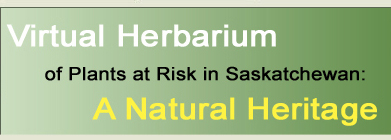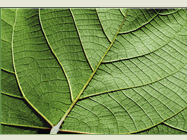|
| Polygonum punctatum
var. confertiflorum (Meisn.) Fassett |
|
| |
| TAXONOMY |
| |
| Family: |
Polygonaceae |
| Genus: |
Polygonum |
| |
| Species Synonyms: |
Persicaria punctata (Ell.) Small
Persicaria punctata var. leptostachya (Meisn.) Small
Polygonum punctatum var. leptostachyum (Meisn.) Small
Polygonum punctatum var. parvum Victorin & Rouss. |
| Common Names: |
dotted smartweed |
| |
| DISTRIBUTION |
| |
| Canada: |
southern British Columbia, central Saskatchewan
– Manitoba – Ontario – Quebec – New Brunswick –
Nova Scotia |
| Saskatchewan: |
central Saskatchewan; Buffalo Narrows –
Ile-a-la-Crosse – Lac la Ronge – Jan Lake – Amisk Lake |
| Ecoregion: |
Mid-Boreal Upland, Churchill River Upland |
| |
| HABITAT |
| |
| Saskatchewan: |
wet, marshy or gravelly shores, forests, bogs
or wet fens |
| Associated Species: |
jackpine, white spruce |
| |
| RARITY STATUS |
| |
Provincial
Status According
to Harms (2003): |
Threatened |
| Nature Conservancy
Status: |
G5T5 S1 |
Saskatchewan
Species at
Risk Status: |
None |
| COSEWIC Status:
|
None |
| |
| Dotted smartweed
is threatened because of rarity in Saskatchewan. No threats are known for
this species but may occur in the future. |
| |
| SPECIES
DESCRIPTION |
| |
| Height: |
15 – 120 cm |
| Roots: |
often arising from proximal nodes; rhizomes often
present |
| Stem: |
annual or perennial, ascending to erect, simple
or branched, hairless, glandular-dotted |
| Leaves: |
stalk 0.1 – 1 cm long, glandular-dotted;
blade 4 – 10 cm long, 6 – 24 mm wide, lance-shaped to oval,
face hairless or rough hairy, glandular-dotted, margin stiff-hairy; stipules
fused 9 – 18 mm long, papery, base inflated, brown, glandular-dotted |
| Inflorescence: |
usually terminal, erect, interrupted, to 10 cm
long, flowers 2 – 6 per secondary stipule; inflorescence stalk 3 –
6 cm long, hairless, glandular-dotted; fused stipules at the base of the
inflorescence stalks not usually overlapping |
| Flowers: |
tepals 5, 3.5 – 5 mm long, fused, greenish
proximally, whitish distally, glandular-dotted; stamens 6 – 8, included,
anthers pink or red |
| Fruits: |
brownish-black |
| |
| POLYGONUM
KEY FOR SPECIES FOUND IN SASKATCHEWAN |
| |
| 1 Flowers solitary or in small axillary
clusters; leaves jointed at the base with the stalk, small; outer tepals
may be boat-shaped; fused stipules often dry and membranous, 2-lobed |
2 |
| 1 Flowers in spike-like clusters;
leaves not jointed at the base with the stalk, large; outer tepals may be
winged or unwinged, but not boat-shaped (except in P. cilinode and P. convolvulus);
fused stipules papery |
9 |
| |
|
2 Inflorescence compact
|
3 |
| 2 Inflorescence a slender, open, unbranched |
5 |
| |
|
| 3 Fruits black, smooth and shiny;
tepals rounded |
P. spergulariiforme |
| 3 Fruits yellowish to dark brown,
not shiny; tepals pointed |
4 |
| |
|
| 4 Bracts definitely white-margined;
stems to 20 cm tall |
P. polygaloides var. confertiflorum |
| 4 Bracts only slightly white-margined,
if at all; stems less than 20 cm |
P. polygaloides var. kelloggii |
| |
|
| 5 Flowers on reflexed stalks |
P. douglasii ssp. douglasii |
| 5 Flowers ascending or spreading |
6 |
| |
|
| 6 Fruits shiny; leaves linear to lance-shaped |
P. ramosissimum |
| 6 Fruits dull; leaves oval |
7 |
| |
|
| 7 Tepals bottle-shaped, outer tepal
hooded |
P. achoreum |
| 7 Tepals not constricted below the
tip, outer tepal not hooded |
8 |
| |
|
| 8 Leaves on the branches the same
size as the ones attached directly to the stem; sepals with greenish-white
or pink margins |
P. arenastrum (= P. aviculare
ssp. depressum) |
| 8 Leaves on the branches much smaller
than the ones attached directly to the stem; sepals with white, pink or
purple margins |
P. aviculare |
| |
|
| 9 Stems slender and twining; leaves
broad, base arrow-shaped |
10 |
| 9 Stems not twining; leaves linear
to lance-shaped, base not arrow-shaped |
12 |
| |
|
| 10 Fused stipules with a ring of bristles |
P. cilinode (= Fallopia cilinodes) |
| 10 Fused stipules lacking bristles |
11 |
| |
|
| 11 Fruiting sepals to 5 mm long, wings
small; plants annual |
P. convolvulus var. convolvulus
(= Fallopia convolvulus) |
| 11 Fruiting sepals to 1.5 cm long,
wings broad; plants perennial |
P. scandens var. scandens (= Fallopia
scandens) |
| |
|
| 12 Leaves mainly basal, stem leaves
few and reduced |
P. viviparum (= Bistorta vivipara) |
| 12 Leaves mainly on the stem, well-developed |
13 |
| |
|
| 13 Fused stipules with bristles at
the summit |
14 |
| 13 Fused stipules without bristles |
15 |
| |
|
| 14 Rhizomes forking; perennials; fused
stipules expanded at the top to create a rim; spikes to 2 cm thick; tepals
not glandular |
P. amphibium var. stipulaceum
(= Persicaria amphibia) |
| 14 Roots fibrous; fused stipules not
expanded at the top; spikes slender, less than 2 cm thick; tepals glandular |
P. punctatum var. confertiflorum
(= Persicaria punctata) |
| |
|
| 15 Annuals, terrestrial; roots fibrous;
spikes terminal and axillary, numerous |
P. lapathifolium var. lapathifolium
(= Persicaria lapathifolia) |
| 15 Perennials, often aquatic; rhizomes
forking; spikes terminal, solitary or paired |
16 |
| |
|
| 16 Leaf stalks attached near base
of fused stipules; leaves and upper stems hairless to sparsely straight-hairy |
P. coccineum var. coccineum
(= Persicaria amphibia) |
| 16 Leaf stalks attached midway on
fused stipules; leaves and upper stems densely ashy-gray hairy |
P. coccineum var. pratincola
(= Persicaria amphibia) |
|






